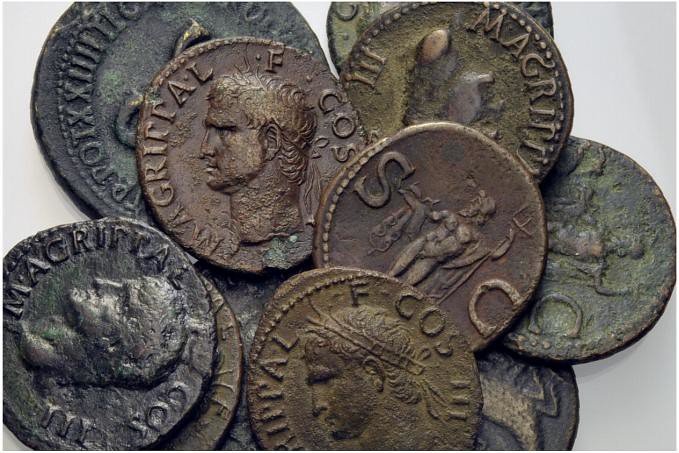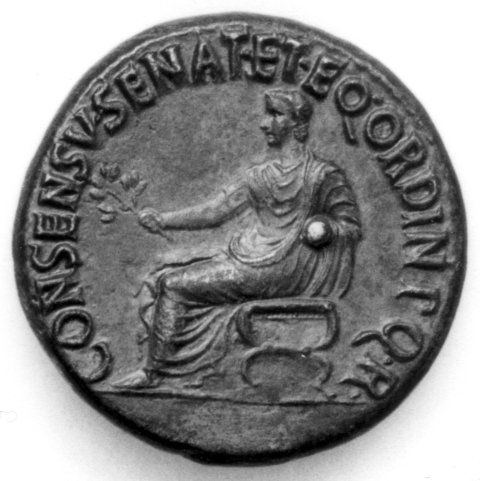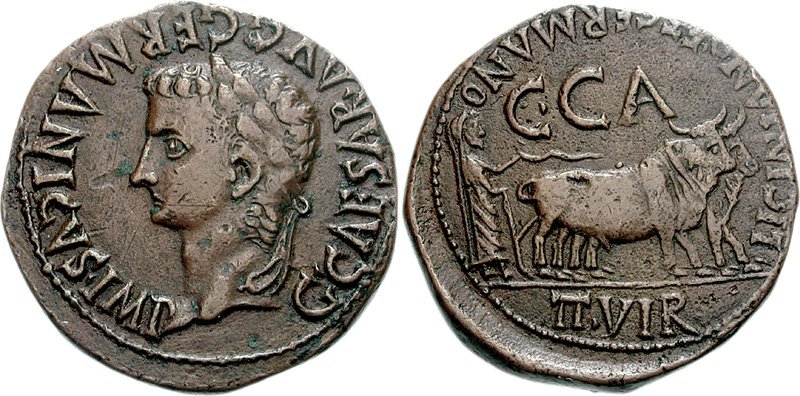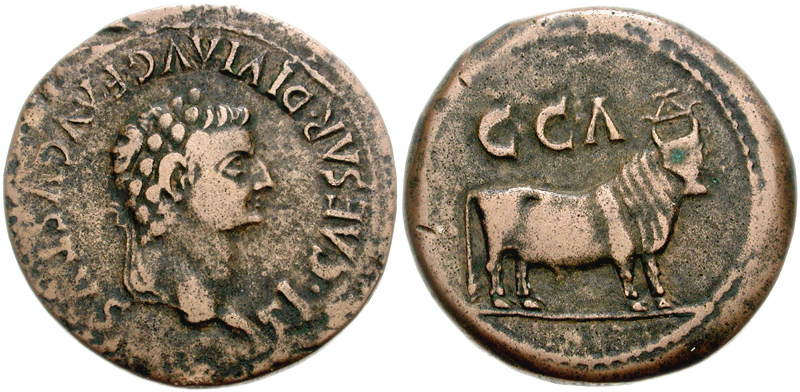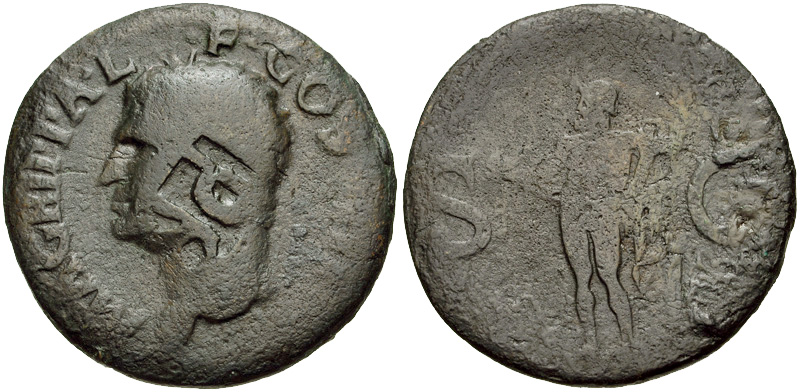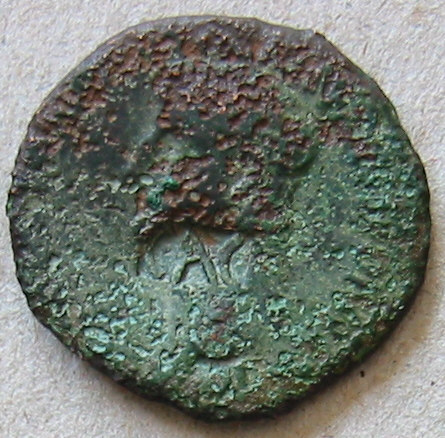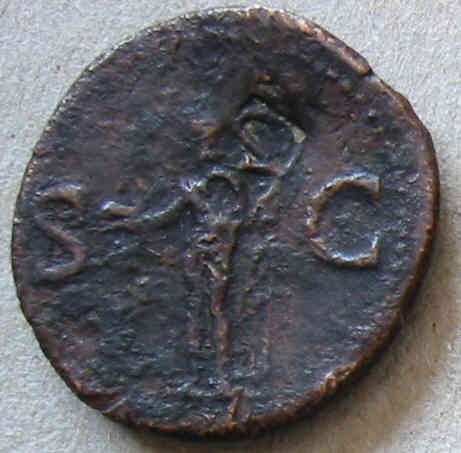just more raw date, more to come.
REVISTING JAMESONS THOUGHTS ON THE
MARCUS AGRIPPA AES- THE DATE OF THE
ASSES OF
MARCUS AGRIPPA Initial theories and changes of the following views of L. Lafranchi-
Due
to familial assimilation stylistic similarity between Agrippan
asses
and the Imperial family of
Caligula, Lafranchi assigned these issues to
the reign of
Caligula. He saw a familial dynastic connection. See
reference below for first theory by Lafranchi.
See: I Diversi stilli nella monetazione romana: gli assi ed I dupondi commeamortivi d Augusto e di
Agrippa, RIN 1910, 21ff.
Lafranchi
changes his mind almost 40 years later on the Agrippan
asses and thinks
they were struck under
Claudius, not
Caligula.
See: La Monetazione Imperatorial e Senatoria di Claudio I Durante il quadrennio 41-44 RIN 1949, 41 ff.
Voetters Views and LaFranchi Response
Voetter
thought that the Agrippan Gaius issues could be assigned to either
principate due to the high volume number of hybrids available.
See:
Vienna Monatsblatter no. 24, 25 and 26. 1908
C.M Kraay- Views on Caligulan or Tiberian Strike
Kraay
first believes that issues were struck under
Caligula, but due to
Kuthmann 's observations on the Caesaraugusta imitations from Spain,
Kraay has changed his mind to a Tiberian strike date.
Original view
by
Kraay: Because there were so many issues of this series of Agrippan
asses with the Claudian
countermark, TIAV. Not commonly found on coins
before
Caligula 's principate.
See: SMzB 1952, 53, and 56.
For Revised
Kraay View, see: Die Munzfunde die Vindonissa 34f.
M.
Grant as
Jameson notes, NC 1948, 116. Grant states the first time an
issue was found with the TIAV
countermark was in 29-30 A.D.
There is
a reference to the Spanish
moneyers reproducing the
Agrippa type with
other types for
Caligula and there is also a mention on an issue of
Caligula being the grandson of
Agrippa from an unknown mint in
Asia
Minor. RN, 1911, 432.
H. Kuthmann 's Views on
Caligula and
Tiberius dates
Due
to the large number of bronze coinage that has survived Kuthmann has
issues with the
Agrippa asses being struck under
Caligula for so brief
of a principate.
See: SMzB 1054, 73ff.
See: For Spanish imitations, A.Vives, La Moneda Hispanica IV, 84, nos. 66-67.
The
M.
Agrippa as series from Spain. Regarding Kuthmann 's observation on
imitations of the
Agrippa aes type from Caesaraugusta in Spain. It seems
in earlier scholarship S.
Jameson,
Kraay and others who get into
Portrait study on these imitations , this is dubious at best, and I
usually always look at portrait types, square chin, or with terms like
"square and sloping styles" as
Kraay mentions for Vindonissa issues.
Which he puts into two groups, one for the
Rome mint and all others for
provincial mints. I do admit that the
Rome mint
Agrippa aes are superior
in
style and consistency, but sometimes this portrait study from
provincial mints can be a bit far reaching? The Roman Imperial mint
would have by far the best portraiture for numismatics and would have
been exactly how the living princeps would have wanted that coin
represented. On the
obverse and I agree with
Jameson that there are
actually three portrait groups we should look at, Group A is of the best
quality and consistency are from Rome-
Group A -
Jameson Observations
A
square set of the
head, and treatment of the eye, which is always
marked HORIZONTALLY" giving a stern and determined appearance (may be
too much read into this) to the
face. The hair is finely executed,
especially the forelock, the tips of which curl slightly outwards, away
from the forehead.
Group A- On Appearance
The
obverse of
the
Agrippa aes issue represents a balanced uncluttered appearance, the
relief is high; the
legend is drawn in large even letters, which are
well spaced and give no impression of cramping the portrait. In
comparison to the other 2 groups the "COS" will be seen to be larger and
equally spaced. At this time , I only would like to concentrate on the
obverse portrait types of
Jameson and not the
reverse.
Group B- More on
Jameson Observations
The
portraits of
Agrippa in group be often look similar to
portraits in
group A, but; the execution of the features is very different. The eyes
vary, sometime the brow is at an angle as though the eye was gazing
upward, the hair is neatly executed but with less detail. Sometimes the
eyebrow is curled, the forelock is either more ruffled or more often
cropped of in a short fringe.
Group B- On Appearance
The
legend of the letters in "COS" often the "O" is smaller the the other
two letters and tends to be spaced closer to the "S", leaving a gap
between it and the "C".
Jameson as well as others believe this group
belong to the Tiberian, Claudian or Neronian deviation.
Group C - Portrait observations
JamesonThe
coins of this group are quite distinct in
style, the
portraits have a
great deal of variation. The main features are similar in that the
head
slopes back and is more spread, the relief being less high , especially
at the base of the neck, the hair is of a courser texture than those of
Groups A and B. The forelock is short and almost always combed into a
fringe which clings tightly to the forehead. The chin is prominent,
often the depth of the chin to base of neck appears greater than that of
forehead to crown.
Groups C- Appearance
The legends in this group are often not consistent, being cramped or has height differences.
Now,
I did not include all of
Jameson 's pyhscological theories on the
Agrippa portrait which seemed to prevail pre- 1970 's. If you want to
know more read:
RIC first edition had this issue struck under
Tiberius BMC
Tiberius 161.
WEIGHT ON JAMESON"S CHART- Three Groups of
Agrippa AesOut
of more than 100 coins Group A shows a Maximum
weight of 13.50 gm ,
this is on the high end , and is extremely heavy, although one-third
weigh between 11.50 and 12.50 gm. And the
weight for any issue never
drops below 10.25 gm.
Average weight is between 10.25 and 11.00. Group B
and Group C are averaging the same but
weights decline respectively
from groups A, B and C.
THE
DIE AXIS RELATIONSHIP
In the
case of the Tiberian issue , it has been shown , on the evidence of the
die axis relationship and the types with which the
Agrippa portrait is
combined to form hybrids , that probably originated in mid range of
Tiberian rule. The
Agrippa as groups issued under
Tiberius was probably
around 22-23 A.D.
Jameson goes on, the
die axis under
Caligula is
ÓÔ , BUT; this is also so in the reign of
Tiberius, with two exceptions
(neither
asses). The
Agrippa coins always have the
reverse die-axis in a
downward position.
Sutherland has demonstrated from an examination of
the die-axis of the aes coinage throughout the reign of
Tiberius that
while hh is dominant at the beginning and end of the reign , *¯
predominates during mid reign. In particular the providential
asses. Of
the 29
asses of the
Agrippa type, both countermarked and
non-countermarked, the
reverse die-axis is a follows: 10 specimens show
¯, 10 l, and 9 m. Therefore , if these issues are correctly attributed
to
Tiberius, they are more likely to have been attributed to the middle
part of his reign. 22-23 A.D.
See: NC, 1941 100 and for Provedentia
asses 111.
Marcus Agrippa, a Biography, (
Roma 1965) , no. 132. No.39. Dating and methods of explaining
Agrippa issues and hybrids.
Jameson Legends for Hybrids Evidence
IMP
CAESAR DIVI F AVGVS IMP XX
DIVVS AVGVSTUS PATERTI CAESAR DIVI AVG F AVGVST PM
TR POT XXIII? SC
TI CAESAR DIVI AVG F PM
TR POT XXIIII SC
PONTIF MAXIM TRIBUN POTEST XXXVII SC
PONTIF MAXIM TRIBUN POTEST XXXVIII SC
SC PROVIDENT
CCAESAR AVG
GERMANICVS PON M TR POTSC (
MINERVA)
ROME ET AVG (LOCAL
STYLE)
THE
REVERSE OF THE
AGRIPPA AES - SC
Group A - SC
The
SC from group A of Jameson/Kraay 's (Die Munzefunde von vindonissa 35)
chart shows the extremely large bold SC , the C is very round and almost
a full
circle. On better specimens the C varies in thickness according
to
Jameson.
If the SC is studied on the Tiberian aes is studied ,
they do not seem so rotund, more square than round. The letters
themselves are thicker , the C is not fully fashioned on the Tiberian
issue as on Group A
asses, but broadens into the serifs.
As is sometimes
the case with the "C" of Claudian
asses.
Jameson goes into great depth
on these issues of legends and serifs and
flan distinction, see page
109-10 of NC , Vol. VI, 1966.

